What is a power distribution unit (PDU)?
A power distribution unit (PDU) is a device for controlling data center electrical power. The most basic PDUs are large power strips without surge protection. They are designed to provide standard electrical outlets for data center equipment and have no monitoring or remote access capabilities. More advanced PDUs provide real-time monitoring and remote access capabilities.
Power distribution units are designed to forward alternating current (AC) from a power source to multiple devices in the data center. PDUs can be portable, mounted on the data center floor or installed directly on a data center rack. Data center devices plug into outlets on the PDU to receive their electrical power.
PDUs are used in environments where ordinary power strips and surge protectors cannot meet electrical power requirements safely and/or reliably. Organizations with complex data centers can use intelligent PDUs to manage power to specific outlets on the PDU remotely and improve uptime by identifying and resolving power issues before they cause equipment failures.
According to a report published by Allied Market Research in 2025, the market for PDUs is expected to reach $7.9 billion by 2030. Industry experts often attribute the continued growth of this market to a growing reliance on cloud computing and the rapid expansion of data centers to meet the needs of digital transformation initiatives.
What do PDUs do?
PDUs do essentially the same job as power strips: They supply power to multiple items at once. Data centers and other industrial environments cannot plug all their devices into one power supply -- there are just too many of them. Instead, PDUs distribute power to multiple devices, including servers, routers, switches and telecommunications equipment. One PDU can provide power for up to 48 devices simultaneously, depending on the form factor and use case.
In most data center environments, a single PDU is installed on each rack to distribute power to all the equipment housed within that rack. This setup simplifies power management and helps administrators organize power delivery on a per-rack basis.
It should be noted, however, that racks containing mission-critical data center components are often equipped with more than one PDU, each of which connects to a separate power source. This allows failover and continued operation if one power source or PDU fails.
Racks that contain blade servers or graphics processing unit (GPU)-intensive systems might also require multiple PDUs to deliver enough current safely. Blade servers and GPU workloads draw more current per unit of rack space compared to standard servers, which can lead to load imbalances or even overload conditions if only one PDU is used.
How do PDUs work?
While all PDUs serve the basic function of delivering power to multiple devices, they vary significantly in terms of monitoring capabilities and control features.
Basic PDUs. These units work the same way as a heavy-duty power strip. They distribute power from a single input source to multiple output outlets without any monitoring or remote control. Basic PDU units are commonly used in small businesses that prioritize simplicity and cost-effectiveness.

Metered PDUs. These work like basic PDUs, but they have a digital display that shows real-time data about electrical power consumption. Metered PDUs are helpful for load balancing and avoiding overcapacity issues, especially when metering is done at the outlet level.
Monitored PDUs. Sometimes called intelligent PDUs, these units give administrators real-time visibility into power usage, but they don't allow admins to remotely control individual outlets.

Switched PDUs. These are like metered PDUs that can be controlled remotely. In addition to providing metered power data, this type of PDU lets administrators remotely power devices on or off at individual outlets. This is especially useful for rebooting unresponsive equipment remotely.

Automatic transfer switch (ATS) PDUs. ATS units provide redundancy for single-corded devices. This type of PDU has dual power inputs and can automatically switch from the primary power source to the secondary source if a failure is detected.
Dual-circuit PDUs. These have two power cords, each of which feeds a separate set of outlets. This enables devices that already have dual power supplies to plug into both circuits for redundancy.
High-density PDUs. These units are built for data centers that run high-performance computing workloads or have dense server configurations. This type of PDU can handle very high power loads and typically offers different outlet configurations to support a wide range of devices.
Specialized PDUs. These are hybrid industrial PDUs that can often deliver AC and direct current (DC) distributions simultaneously. DC power is used in specialized environments, such as telecom facilities or hyperscale cloud data centers that have DC power architectures.

What are the different types of PDU form factors?
Power distribution units come in several form factors to suit different environments and power needs. Each type of PDU plays a specific role depending on an organization's power management needs, scalability goals and operational priorities.
Rackmount PDUs. These are used in data centers to deliver power to rack-mounted data center equipment. Advanced intelligent models can monitor and control power at the outlet level and assist with load balancing.
Floor-standing PDUs. These serve as intermediate distribution points between upstream power from an uninterruptible power supply or generator and rack-mounted PDUs. Floor-standing PDUs might also be referred to as remote power panels.
Power distribution cabinets. These floor-standing PDUs include circuit breakers and electrical monitoring panels. This type of PDU is typically used in high-density, enterprise-class data centers to manage large volumes of power safely and efficiently.
Portable PDUs. Portable units are not mounted to racks and are intended for light-duty power distribution. They resemble industrial-grade power strips and are used in settings where flexible, mobile power distribution is required.
Basic PDUs vs. intelligent PDUs
Basic PDUs are essentially high-capacity power strips designed for use in industrial or IT environments. They distribute power from a single source to multiple outlets and enable multiple devices to be powered from a central point. Basic PDUs are typically used in environments where cost efficiency is important and the requirements for power distribution are straightforward.
In contrast, intelligent PDUs, which might also be referred to as smart or managed PDUs, often have real-time power monitoring features that let IT administrators remotely monitor voltage, current and power usage through a web-based interface or Simple Network Management Protocol tools. If the intelligent PDU supports remote power cycling, administrators can also reboot individual devices that connect to the PDU without having to be physically present.
Some high-end intelligent PDUs can share monitoring data with the organization's data center infrastructure management (DCIM) system. This capability is especially valuable in lights-out data centers and distributed cloud data center environments where uptime, energy efficiency and remote management capabilities are important.

Benefits of intelligent PDUs
Unlike basic PDUs that simply distribute electrical power, intelligent PDUs enable IT administrators to remotely monitor power consumption at the device or outlet level. The monitoring data can be used to identify which racks are using the most electricity and which racks are not being used to their full capacity. Many intelligent PDUs also support remote outlet control capabilities that let administrators turn off devices that are not in use. In a large data center, this can reduce both energy waste and operating costs.
Intelligent PDUs also play an important role in calculating a data center's power usage effectiveness (PUE). PUE is a metric that quantifies how efficiently a data center uses electricity. It's calculated, as noted in the following equation, by dividing the total power entering the data center by the power used by the IT equipment:
PUE = Total facility power / IT equipment power
The impact of AI on PDUs
Artificial intelligence has made it easier and more cost-effective to integrate and analyze the data collected by intelligent PDUs with other systems. For example, DCIM platforms and cloud-based analytics tools can combine PDU data with other infrastructure data to do the following:
- Analyze trends in power consumption.
- Optimize workload placement for energy efficiency.
- Predict failures or overload risks.
- Automate responses to power anomalies.
Challenges of using PDUs
Power distribution units offer many advantages, but their use in data centers also comes with challenges that IT teams need to manage carefully.
One of the biggest challenges is keeping the workflow for power planning and provisioning as simple as possible. As data center workloads grow and equipment densities increase, it becomes more difficult for administrators to predict how much power will be needed per rack and distribute power efficiently without overloading circuits or wasting capacity.
Cable management and physical installations are another challenge. High-density PDUs, especially rack-mounted PDUs with lots of outlets, can create cable congestion. When too many cables are routed in close proximity, it can restrict the airflow needed to cool servers and other data center devices.
Cost is also a factor. While basic PDUs are relatively inexpensive, intelligent PDUs that can be integrated with the organization's DCIM system can cost thousands of dollars more. Not all PDUs use the same communication protocols or interfaces, and organizations might need to invest in middleware or purchase customized PDUs to enable seamless integration.
Finally, it's important to understand that security is an increasing concern for intelligent PDUs. Like other network devices, intelligent PDUs can be vulnerable to unauthorized access or cyberattacks if they are not properly secured.
PDU manufacturers
Strong access controls and network segmentation can help protect PDUs, but a thoughtful approach to choosing the right vendor and type of PDU is also important. Numerous companies manufacture power distribution units. Here is a brief list of manufacturers:
- APC by Schneider Electric.
- Aten.
- Belden.
- CyberPower.
- Delta Electronics.
- Eaton.
- Enconnex.
- Raritan.
- Server Technology.
- Vertiv.
When purchasing a PDU, it's important to understand that cost considerations should not be limited to the PDU's purchase price. Installation, maintenance requirements and warranties should all factor into total cost of ownership and influence both vendor selection and model selection.
Choosing the right PDU
Before acquiring a new power distribution unit, an organization must decide on the type of PDU it needs. Technical specifications to look at and questions to ask vendors when making this decision include the following:
- Where will the PDU be installed? It's important to determine whether the PDU will be mounted on a rack, placed on the floor or housed in a cabinet. Be sure to consider factors such as vertical or horizontal orientation, the amount of physical space the PDU takes up and airflow requirements.
- What type of input power is required? Consider whether the PDU will only handle AC input or whether it will also need to handle DC input. Check to make sure the PDU under consideration is actually rated for voltages used in the data center.
- How much power does the equipment need? Calculate the total power draw of the devices connected to the PDU to ensure the unit's maximum load rating will not be exceeded. This requires adding the wattage of all devices that will be connected to the PDU together and comparing the sum with the PDU's maximum load rating. To maintain a safe operating margin, the wattage sum should not exceed 80% of the PDU's rated capacity for continuous use.
- How many outlets are required? Choose a PDU that has enough outlets to meet current needs, as well as extra capacity to accommodate future needs.
- What types of plugs and outlets are needed? Make sure the PDU supports the plug configurations of all connected devices. Some PDUs offer mixed outlet types to provide flexibility.
- What level of redundancy is needed? In mission-critical environments, consider purchasing additional PDUs to serve as failover units.
- Are advanced features required? Intelligent PDUs have varying features and price points. Decide ahead of time whether specific features, such as the ability to integrate with the organization's DCIM, are necessary.
Installing a PDU
The specific steps involved in installing a power distribution unit will vary depending on the type and model. For a standard rackmount PDU, the general installation process typically includes the following steps:
- Determine whether the unit will be mounted vertically (0U) or horizontally (1U or 2U) in the rack. Align the appropriate mounting brackets and attach them securely to the PDU.
- Next, install the PDU by fastening the brackets to the rack rails. Once the PDU is mounted, connect its power cord to the appropriate power source. Be sure to route the power cord carefully to avoid impacting airflow or service paths. Consider using cable ties or straps to prevent strain on the connectors.
- After the power distribution unit is connected to power, it's time to connect servers and other IT devices to the PDU's outlets.
- Finally, turn on the PDU's power (if it has a power switch) and verify that each outlet is functioning correctly. Administrators for intelligent PDUs can use the PDU's user interface to verify outlet status and electrical power consumption.
PDU vs. PSU: What is the difference?
The terms PDU and PSU (power supply unit) are often confused. Both types of units deal with power, but they have very different purposes. A PDU distributes electrical power to multiple devices, while a PSU is a device component that converts the power it receives into a usable format.
In most data centers, AC is the standard form of electricity supplied by utility companies. Once the AC power reaches each device, however, it needs to be converted into DC power because that's what internal computer components use to operate. Essentially, the PDU delivers power to devices, and a PSU makes that power usable within each individual device.
Learn why the future of the electrical grid is expected to be closely tied to how data centers use electricity.






